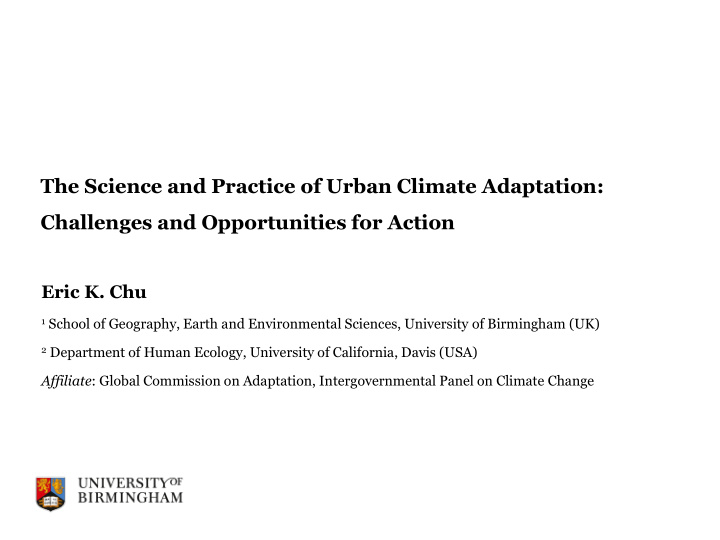



The Science and Practice of Urban Climate Adaptation: Challenges and Opportunities for Action Eric K. Chu 1 School of Geography, Earth and Environmental Sciences, University of Birmingham (UK) 2 Department of Human Ecology, University of California, Davis (USA) Affiliate : Global Commission on Adaptation, Intergovernmental Panel on Climate Change
Why Study Climate Adaptation in Cities? Climate change will disproportionately impact poor communities -- many of which are in cities -- because of their higher exposure to environmental hazards, lower response capacity, and lower access resources and services. Integrating climate adaptation is key for facilitating responses to impacts and supporting development, but adaptation has a distinct ‘logic’. Cities and local communities are increasingly nodes (or ‘laboratories’ of climate adaptation and resilience action.
The Adaptation Imperative • Emphasis in cities has been on climate mitigation • However, cities are recognizing the need to initiate adaptation planning and implement adaptation measures
The “Logic” of Climate Adaptation • Draws on typical planning tools and strategies • Relies on strong leadership • Strong tendencies for experimentation and incremental change • Mainly institutional in nature Source: Shi, L, E Chu, & J Debats. 2015. “Explaining Progress in Climate Adaptation Planning Across 156 U.S. Municipalities.” Journal of the American Planning Association 81 (3): 191 – 202.
However… • We now have ± 10 years of experience in urban adaptation/resilience. • There is growing global recognition of adaptation and resilience needs. We have moved from institutionalization to implementation. • Two Examples …
New York City Layers showing future high tide in the 2020s, 2050s, 2080s, and 2100 are based on NPCC’s projections for SLR in New York City.
Task Force Creation in New York City
Adaptation Strategies Dealing with urban heat through street trees, cool roofs, cool pavements, different kinds of green infrastructure, together with launching climate risk training in at-risk neighborhoods. Revitalizing waterfronts by introducing building set-backs, permeable surfaces, strengthening and ‘greening’ coastal infrastructure.
The ‘ Big U ’ or ‘ Dry Line ’
Jakarta, Indonesia Capital city experiencing high urbanization rates. • • Long history of land subsidence and urban inundation. • City increasingly vulnerable to sea level rise. • Capital region plan published in 2014. Then abandoned … Jakarta Metropolitan Region, 1976, 1989, 2004 (NASA)
Source: Yosef Riadi for NPR
Source: National Capital Integrated Development Plan (2014)
Another view...
Ciliwung Merdeka with researchers and residents of Bukit Duri and Muara Bara, July 2013 (photo credit: Kian Goh) Ciliwung Merdeka’s “humanitarian vertical kampung” design, part of Jakarta Vertical Kampung exhibition
Insights so far …
Visioning Resilient Urban Futures The contesting narratives of change: • Development for growth, productivity, investment, and security. • Prioritizing livability and environmental ‘utopianism’. A need to unpack the their sources, incentives, and consequences: The role of global capital (and speculative forms of technology). • Real impacts on emissions reduction, risk management, and sustainability? • Example of Eko Atlantic City in Nigeria
Reorienting Behaviors and Values Enabling change through: • Policy and legislative action • Financial and social incentives • Knowledge and awareness Complexity derived from: • Politics and ideology • Values of urban system components Negotiating diverse (and likely • conflicting) interests
Focusing on Fairness and Equity Dealing with the ‘winners’ and ‘losers’ of adaptation action: • Building inclusive participatory processes. Recognizing interests of the vulnerable and marginalized. • • (Re)distributing goods, infrastructures, and services.
What Does This Mean for Practitioners? Climate adaptation entails deep societal, political, and cultural shifts. • Diagnosing the drivers of underdevelopment , vulnerability , and marginality , but situating these local experiences in the context of environmental change. • Adaptation actions are contentious, with conflicting visions of what ought to be and how we should get there . An opportunity for cities to radically rethink the structure of politics, economy, • culture, and society ( and to position themselves in global conversations ).
Looking Forward… Setting the parameters for pathways towards climate adaptation. Three entry points for discussion: • What is the vision of adaptive/resilient cities and does this also support climate mitigation and environmental sustainability priorities? • How do we value and prioritize climate adaptation actions? • In what ways do actions address structural drivers of vulnerability, poverty, and inequality? How do we deal with conflicts that may arise? • • Which voices are recognized, validated, and included in the process?
The Science and Practice of Urban Climate Adaptation: Challenges and Opportunities for Action Eric K. Chu 1 School of Geography, Earth and Environmental Sciences, University of Birmingham (UK) 2 Department of Human Ecology, University of California, Davis (USA) Affiliate : Global Commission on Adaptation, Intergovernmental Panel on Climate Change
Recommend
More recommend